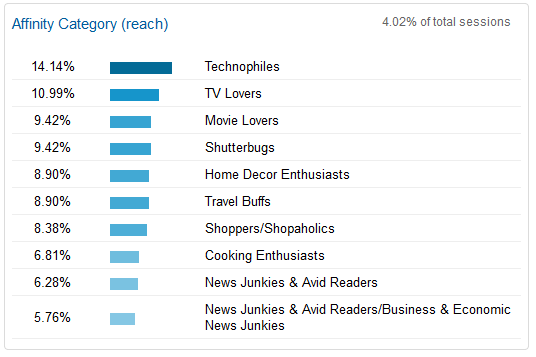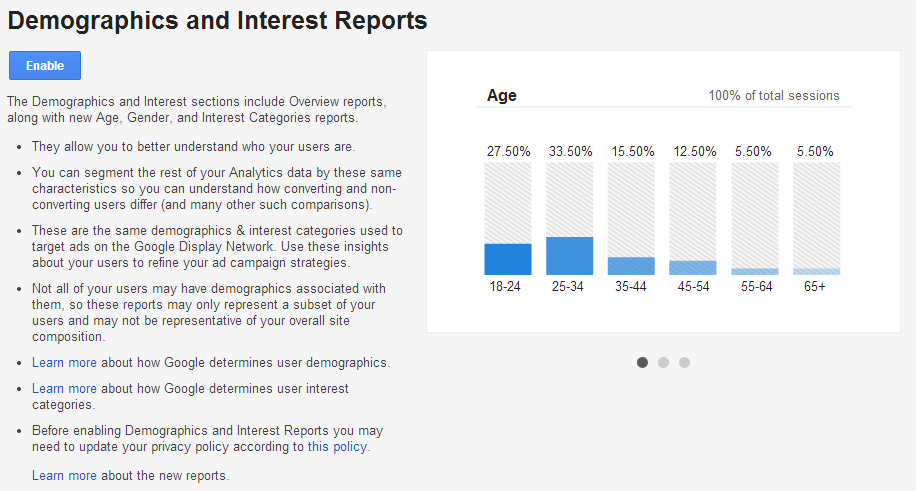about Universal Analytics and why it’s time to upgrade, and acknowledged that many marketers have been hesitant to switch over from Classic Analytics while some features still weren’t available in the Universal Analytics upgrade. However, now that Phase 3 of Universal Analytics has been rolled out, there’s really no reason to wait anymore.
Along with a few other key features (like Remarketing), you can now enable Demographics & Interests reports. We’re encouraging all of our clients to enable this reporting in Analytics, as it has the potential to provide some interesting and valuable insight for interest targeting going forward.
Demographics & Interests reports give you deeper insight into your audience, and allow you to see things like the types of users interacting with your content and which groups are your highest-value customers.
You can collect data on things like your users’ age, gender and specific interests. You can then analyze how many of your users engage over a set period of time, who they are (i.e. 30-year-old female or 45-year-old male, etc.), and how their behavior changes based on their or interests or demographics. For example, do females interested in B2B marketing convert more often or read specific types of content more than males who are interested in finance?
[caption id="attachment_3087" align="aligncenter" width="536"] Example interests in Google Analytics Interests Reports.[/caption]
There are three simple steps to enabling Demographics & Interests reports in Universal Analytics:
1. In order to support any kind of Display Advertising, you’ll need to make a simple, one-time update to your Analytics tracking code to collect info from the DoubleClick cookie. If you’ve made any other previous customizations to the code, don’t worry, this change won’t affect them.
If you’ve already upgraded to Universal Analytics (as you should have), simply insert the bold line of code below into your existing tracking code, between the ‘create’ and ‘send’commands.
Example:
<script>
(function(i,s,o,g,r,a,m){i[‘GoogleAnalyticsObject’]=r;i[r]=i[r]||function(){
(i[r].q=i[r].q||[]).push(arguments)},i[r].l=1*new Date();a=s.createElement(o),
m=s.getElementsByTagName(o)[0];a.async=1;a.src=g;m.parentNode.insertBefore(a,m)
})(window,document,’script’,’//www.google-analytics.com/analytics.js’,’ga’);
ga(‘create’, ‘UA-XXXXXX-XX’, ‘example.com’);
ga(‘require’, ‘displayfeatures’);
ga(‘send’, ‘pageview’);
</script>
If you still insist on using Classic Analytics you will need a different code to support Display Advertising, which can be found here.
2. After you update your tracking code, you will also need to update your privacy policy, notifying your visitors about the new advertising features you’ve implemented in Analytics, and how you and third-party vendors will be using their first-party info. Here are the official policy requirements for Google Analytics Advertising Features.
3. Lastly, you just need to enable Demographics reports in the Analytics interface (you’ll need to have Edit permission to do this). After you sign in to Analytics, click Admin, select the property you want, and click Property Settings. Under Display Advertiser Features, enable the option for Demographics and Interests Reports.
[caption id="attachment_3085" align="aligncenter" width="764"]
Example interests in Google Analytics Interests Reports.[/caption]
There are three simple steps to enabling Demographics & Interests reports in Universal Analytics:
1. In order to support any kind of Display Advertising, you’ll need to make a simple, one-time update to your Analytics tracking code to collect info from the DoubleClick cookie. If you’ve made any other previous customizations to the code, don’t worry, this change won’t affect them.
If you’ve already upgraded to Universal Analytics (as you should have), simply insert the bold line of code below into your existing tracking code, between the ‘create’ and ‘send’commands.
Example:
<script>
(function(i,s,o,g,r,a,m){i[‘GoogleAnalyticsObject’]=r;i[r]=i[r]||function(){
(i[r].q=i[r].q||[]).push(arguments)},i[r].l=1*new Date();a=s.createElement(o),
m=s.getElementsByTagName(o)[0];a.async=1;a.src=g;m.parentNode.insertBefore(a,m)
})(window,document,’script’,’//www.google-analytics.com/analytics.js’,’ga’);
ga(‘create’, ‘UA-XXXXXX-XX’, ‘example.com’);
ga(‘require’, ‘displayfeatures’);
ga(‘send’, ‘pageview’);
</script>
If you still insist on using Classic Analytics you will need a different code to support Display Advertising, which can be found here.
2. After you update your tracking code, you will also need to update your privacy policy, notifying your visitors about the new advertising features you’ve implemented in Analytics, and how you and third-party vendors will be using their first-party info. Here are the official policy requirements for Google Analytics Advertising Features.
3. Lastly, you just need to enable Demographics reports in the Analytics interface (you’ll need to have Edit permission to do this). After you sign in to Analytics, click Admin, select the property you want, and click Property Settings. Under Display Advertiser Features, enable the option for Demographics and Interests Reports.
[caption id="attachment_3085" align="aligncenter" width="764"] After signing into Google Analytics, enable the option for Demographics and Interests Reports in the Admin space.[/caption]
You can also do this through the Demographics Overview report. When you’re signed into Analytics, click Reporting, then Audience on the left hand side. Click Demographics, then Overview. Click the blue Enable button above the introductory text.
[caption id="attachment_3086" align="aligncenter" width="916"]
After signing into Google Analytics, enable the option for Demographics and Interests Reports in the Admin space.[/caption]
You can also do this through the Demographics Overview report. When you’re signed into Analytics, click Reporting, then Audience on the left hand side. Click Demographics, then Overview. Click the blue Enable button above the introductory text.
[caption id="attachment_3086" align="aligncenter" width="916"] Enable Demographics & Interests Reports in the Demographics Overview report.[/caption]
Once the reports are set up, you can use the data to better target your ads and tailor your content to increase conversions. Think about focusing ad spend to acquire or retain high-value audiences, or eliminating spend on audiences that are too low-value. Tailoring your ads for each segment can also be an effective way to get more conversions.
It’s not always about ads, either – you might decide you want to change the content on your website to target high-value audiences, or split up your remarketing lists by age, gender, or interests for further optimization.
Remember, these are the same demographics and interest categories you use to target ads on the Google Display Network, so when you build segments with these attributes, you can then apply them to any of your Analytics reports, and use that analysis to improve your campaign strategies. Bottom line – Demographics and Interests reports are easy to implement and have the ability to provide valuable insight into your campaigns.]]>
Enable Demographics & Interests Reports in the Demographics Overview report.[/caption]
Once the reports are set up, you can use the data to better target your ads and tailor your content to increase conversions. Think about focusing ad spend to acquire or retain high-value audiences, or eliminating spend on audiences that are too low-value. Tailoring your ads for each segment can also be an effective way to get more conversions.
It’s not always about ads, either – you might decide you want to change the content on your website to target high-value audiences, or split up your remarketing lists by age, gender, or interests for further optimization.
Remember, these are the same demographics and interest categories you use to target ads on the Google Display Network, so when you build segments with these attributes, you can then apply them to any of your Analytics reports, and use that analysis to improve your campaign strategies. Bottom line – Demographics and Interests reports are easy to implement and have the ability to provide valuable insight into your campaigns.]]>
Blog
